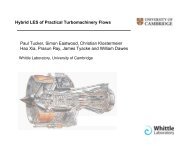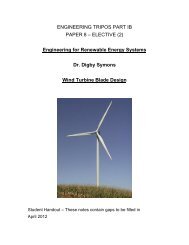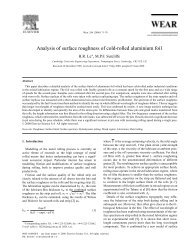Pedestrian excitation of bridges - University of Cambridge
Pedestrian excitation of bridges - University of Cambridge
Pedestrian excitation of bridges - University of Cambridge
You also want an ePaper? Increase the reach of your titles
YUMPU automatically turns print PDFs into web optimized ePapers that Google loves.
482<br />
and deck maintained a constant phase relation.’ However,<br />
‘Other walking patterns, some involving crossing<br />
<strong>of</strong> the feet, some involving walking in undulating lines<br />
were also observed’ [6]. They also found that the lateral<br />
forces <strong>of</strong> the feet-apart gait are phase synchronized to<br />
the structure and approach 300 N amplitude per person,<br />
which these researchers pointed out is four times the<br />
Eurocode DLM1 value <strong>of</strong> 70 N for normal walking.<br />
5 SMALL-AMPLITUDE PEDESTRIAN LOADING<br />
MODEL<br />
The previous considerations lead to the notion that the<br />
force exerted by a walking pedestrian can be modelled<br />
(approximately) as two mass6acceleration terms. The<br />
rst arises from the natural displacement <strong>of</strong> a person’s<br />
centre <strong>of</strong> mass while walking on a stationary pavement,<br />
and the second from the additional displacement that<br />
occurs as a consequence <strong>of</strong> movement <strong>of</strong> the pavement.<br />
Let x…t† be the natural movement <strong>of</strong> the centre <strong>of</strong> mass<br />
on a stationary pavement and y…t† the movement <strong>of</strong> the<br />
pavement; then, if f0…t† is the force per person <strong>of</strong> mass m<br />
exerted on the pavement,<br />
f 0…t† ˆ m x…t† ‡ may…t ¡ D† …1†<br />
where D is a time lag to account for the fact that a<br />
person’s centre <strong>of</strong> mass will generally not move in phase<br />
with movement <strong>of</strong> the pavement and a is a proportionality<br />
factor relating centre-<strong>of</strong>-mass movement to pavement<br />
movement. For lateral forces, the data in F ig. 2<br />
suggest, for walking comfortably at about 0.85 Hz (1.7<br />
paces/s) that a suitable value for a is 2/3 and that the<br />
amplitude <strong>of</strong> x…t† would be about jxj ˆ 15 mm. These<br />
are the values used to plot the middle line in F ig. 2.<br />
The same equation (1) applies for modal quantities<br />
when there are many pedestrians provided that, at any<br />
point on the bridge, all <strong>of</strong> them are moving together.<br />
The modal force f …t† now replaces the force per person<br />
f 0…t†, m becomes the modal mass <strong>of</strong> pedestrians (i.e. the<br />
distributed pedestrian mass normalized by the square <strong>of</strong><br />
the bridge’s displacement mode function), and x and y<br />
become modal displacements (both normalized by the<br />
bridge’s displacement mode function).<br />
However, it has been found experimentally that<br />
pedestrians do not always synchronize their steps (see<br />
F ig. 3), and only forces that are synchronized (i.e.<br />
correlated in time) cause bridge vibration, the uncorrelated<br />
forces cancelling each other out. Therefore we<br />
de ne two correlation coef cients: b to describe the<br />
correlation <strong>of</strong> the natural swaying movements that<br />
people make walking on a stationary platform, and g to<br />
describe the correlation <strong>of</strong> the pedestrian movements<br />
that depend on platform movement. Introducing these<br />
D E NEWLAND<br />
factors into equation (1) gives<br />
f …t† ˆ mbx…t† ‡ magy…t ¡ D† …2†<br />
F or small pavement movements (up to 10 mm amplitude),<br />
there are currently insuf cient experimental data<br />
to determine whether b and g are different and it will be<br />
assumed that they are the same (and constant), so that<br />
b ˆ g ˆ constant …3†<br />
The upshot is that it will be assumed that the following<br />
equation applies to describe how the modal bridge<br />
<strong>excitation</strong> force arising from pedestrian motion depends<br />
on the modal accelerations <strong>of</strong> the people and the bridge,<br />
and the modal mass <strong>of</strong> pedestrians. It includes the two<br />
empirical factors a, which is the ratio <strong>of</strong> movement <strong>of</strong> a<br />
person’s centre <strong>of</strong> mass to movement <strong>of</strong> the pavement,<br />
and b, which is a correlation factor for when individual<br />
people’s movements synchronize. Thus, to a rst<br />
approximation, the bridge loading to be expected from<br />
walking pedestrians will be modelled by the equation<br />
f …t† ˆ mbx…t† ‡ maby…t ¡ D† …4†<br />
The de nitions <strong>of</strong> all terms are given in the notation<br />
section and the quantities in equation (4) can be<br />
interpreted either as modal quantities or as local<br />
quantities per unit length.<br />
Note that the presence <strong>of</strong> pedestrians is assumed not<br />
to alter the bridge’s modal properties which are<br />
satisfactorily described by small damping theory.<br />
<strong>Pedestrian</strong>s act only as a forcing function for the bridge<br />
modes, generating a force de ned by equation (4). This<br />
will now be used to compute bridge response.<br />
6 ANALYSIS OF PEDESTRIAN–BRIDGE<br />
INTERACTION<br />
The following calculation explores the interaction<br />
between pedestrians <strong>of</strong> effective modal mass m walking<br />
on a bridge with a vibration mode <strong>of</strong> (modal) mass M<br />
and stiffness K using the above (small-amplitude) force<br />
model. The interaction (modal) force which is transmitted<br />
from the pedestrians to the bridge, and vice<br />
versa, is f. This system is shown in F ig. 4 where z…t† is<br />
Fig. 4 Interaction between a bridge mode with modal mass<br />
M and stiffness K and pedestrians with modal mass m.<br />
The (modal) force transmitted between the pavement<br />
and pedestrians is f. The large open circle recognizes<br />
that there is a complex interaction between pedestrians<br />
and bridge recognized by the time delay D and the<br />
correction factors a and b in equation (7)<br />
Proc. Instn Mech. Engrs Vol. 218 Part C: J. Mechanical Engineering Science C12303 # IMechE 2004







